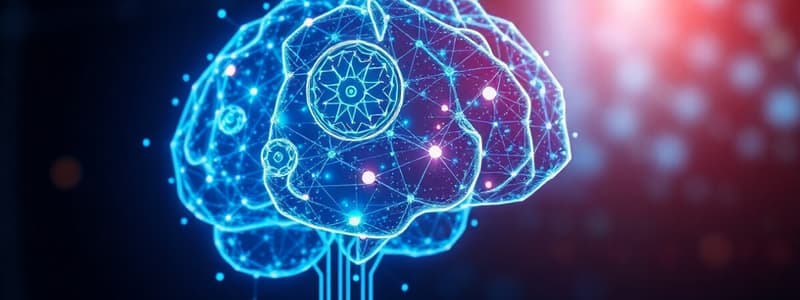Podcast
Questions and Answers
In the context of Natural Language Processing (NLP), which of the following tasks involves identifying the grammatical role of each word in a sentence?
In the context of Natural Language Processing (NLP), which of the following tasks involves identifying the grammatical role of each word in a sentence?
- Sentiment Analysis
- Tokenization
- Named entity recognition
- Part-of-speech tagging (correct)
Which of the following machine learning approaches is best suited for training an AI to play a complex game like chess, where the AI learns by playing against itself and receiving feedback in the form of wins and losses?
Which of the following machine learning approaches is best suited for training an AI to play a complex game like chess, where the AI learns by playing against itself and receiving feedback in the form of wins and losses?
- Supervised learning
- Unsupervised learning
- Semi-supervised learning
- Reinforcement learning (correct)
Which of the following ethical considerations in AI is most directly concerned with the potential for algorithms to unfairly discriminate against certain groups of people?
Which of the following ethical considerations in AI is most directly concerned with the potential for algorithms to unfairly discriminate against certain groups of people?
- Job displacement
- Bias (correct)
- Privacy
- Transparency
Within computer vision, what task focuses on drawing boundaries around specific objects within an image, thereby identifying and locating multiple objects simultaneously?
Within computer vision, what task focuses on drawing boundaries around specific objects within an image, thereby identifying and locating multiple objects simultaneously?
A hospital wants to predict whether a patient will be readmitted within 30 days of discharge, based on their medical history and demographics. Which type of machine learning is most appropriate?
A hospital wants to predict whether a patient will be readmitted within 30 days of discharge, based on their medical history and demographics. Which type of machine learning is most appropriate?
Which of the following best describes the role of Pandas in Python-based data science workflows?
Which of the following best describes the role of Pandas in Python-based data science workflows?
An e-commerce company wants to group its customers into distinct segments based on their purchasing behavior, without any prior knowledge of customer categories. Which machine learning technique is most suitable?
An e-commerce company wants to group its customers into distinct segments based on their purchasing behavior, without any prior knowledge of customer categories. Which machine learning technique is most suitable?
In the context of self-driving cars, which computer vision task is crucial for identifying lane markings, traffic signs, and other vehicles on the road?
In the context of self-driving cars, which computer vision task is crucial for identifying lane markings, traffic signs, and other vehicles on the road?
A financial institution uses AI to assess loan applications, but the algorithm disproportionately denies loans to applicants from low-income areas. Which ethical concern is most evident in this scenario?
A financial institution uses AI to assess loan applications, but the algorithm disproportionately denies loans to applicants from low-income areas. Which ethical concern is most evident in this scenario?
Which of the following is the primary purpose of the NumPy library in Python?
Which of the following is the primary purpose of the NumPy library in Python?
Flashcards
Artificial Intelligence (AI)
Artificial Intelligence (AI)
Simulation of human intelligence in machines programmed to think and act like humans, performing tasks requiring human intelligence.
Machine Learning (ML)
Machine Learning (ML)
A subset of AI focused on enabling systems to learn from data without explicit programming through algorithms.
Supervised Learning
Supervised Learning
Training a model on labeled data where the correct output is known for each input, typically for classification and regression.
Unsupervised Learning
Unsupervised Learning
Signup and view all the flashcards
Reinforcement Learning
Reinforcement Learning
Signup and view all the flashcards
Natural Language Processing (NLP)
Natural Language Processing (NLP)
Signup and view all the flashcards
Tokenization
Tokenization
Signup and view all the flashcards
Computer Vision
Computer Vision
Signup and view all the flashcards
Object Detection
Object Detection
Signup and view all the flashcards
Ethics in AI
Ethics in AI
Signup and view all the flashcards
Study Notes
- Artificial intelligence (AI) refers to the simulation of human intelligence in machines programmed to think and act like humans
- AI encompasses a broad range of techniques and approaches that aim to enable computers to perform tasks that typically require human intelligence
Machine Learning (ML)
- ML is a subset of AI that focuses on enabling systems to learn from data without being explicitly programmed
- ML algorithms allow computers to automatically learn and improve from experience
- Common types of ML include supervised learning, unsupervised learning, and reinforcement learning
Supervised Learning
- Supervised learning involves training a model on a labeled dataset, where the correct output is known for each input
- The model learns to map inputs to outputs based on the provided examples
- Common supervised learning tasks include classification and regression
Unsupervised Learning
- Unsupervised learning involves training a model on an unlabeled dataset, where the correct output is not known
- The model learns to find patterns and relationships in the data without explicit guidance
- Common unsupervised learning tasks include clustering and dimensionality reduction
Reinforcement Learning
- Reinforcement learning involves training an agent to make decisions in an environment to maximize a reward
- The agent learns through trial and error, receiving feedback in the form of rewards or penalties
- Reinforcement learning is commonly used in robotics, game playing, and control systems
Natural Language Processing (NLP)
- NLP is a field of AI that focuses on enabling computers to understand, interpret, and generate human language
- NLP techniques are used in a variety of applications, including machine translation, sentiment analysis, and chatbot development
Core NLP Tasks
- Tokenization: Splitting text into individual words or tokens
- Part-of-speech tagging: Identifying the grammatical role of each word in a sentence
- Named entity recognition: Identifying and classifying named entities, such as people, organizations, and locations
- Sentiment analysis: Determining the sentiment or emotion expressed in a text
- Machine translation: Translating text from one language to another
- Text summarization: Generating a concise summary of a longer text
Computer Vision
- Computer vision is a field of AI that focuses on enabling computers to "see" and interpret images and videos
- Computer vision techniques are used in a variety of applications, including object detection, image recognition, and image segmentation
Core Computer Vision Tasks
- Image classification: Assigning a label to an entire image
- Object detection: Identifying and locating objects within an image
- Image segmentation: Partitioning an image into multiple regions or segments
- Facial recognition: Identifying and verifying faces in an image or video
- Image generation: Creating new images from scratch or based on existing images
Ethics in AI
- Ethics in AI refers to the moral principles and values that should guide the development and deployment of AI systems
- As AI becomes more prevalent, it is crucial to address the ethical implications of its use, ensuring that AI systems are fair, transparent, and accountable
Key Ethical Considerations
- Bias: AI systems can perpetuate and amplify existing biases in data, leading to unfair or discriminatory outcomes
- Transparency: Understanding how AI systems make decisions can be difficult, raising concerns about accountability and trust
- Privacy: AI systems often require large amounts of data, which can compromise individuals' privacy
- Job displacement: AI-powered automation may lead to job losses in certain industries
AI Applications in Industry
- AI is being applied in a wide range of industries to automate tasks, improve efficiency, and create new products and services
- Healthcare: AI is used in medical diagnosis, drug discovery, and personalized medicine
- Finance: AI is used in fraud detection, risk management, and algorithmic trading
- Manufacturing: AI is used in predictive maintenance, quality control, and supply chain optimization
- Retail: AI is used in personalized recommendations, inventory management, and customer service
- Transportation: AI is used in self-driving cars, traffic management, and logistics
Python Data Literacy
- Python is a popular programming language for data science and AI due to its ease of use and extensive libraries
- Data literacy refers to the ability to understand and work with data effectively
- Python provides a rich set of tools and libraries for data manipulation, analysis, and visualization
Key Python Libraries for Data Science
- NumPy: A library for numerical computing, providing support for arrays and mathematical functions
- Pandas: A library for data manipulation and analysis, providing data structures such as DataFrames
- Matplotlib: A library for creating visualizations, such as plots and charts
- Scikit-learn: A library for machine learning, providing a wide range of algorithms and tools
- TensorFlow: An open-source machine learning framework developed by Google
- PyTorch: An open-source machine learning framework developed by Facebook
Studying That Suits You
Use AI to generate personalized quizzes and flashcards to suit your learning preferences.




